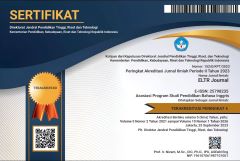PROSPECTIVE INDONESIAN EFL TEACHERS’ PROBLEMS IN PLACING VERB STRESS
Abstrak terlihat: 302 / PDF terunduh: 227DOI:
https://doi.org/10.37147/eltr.v6i2.158Keywords:
problems, prospective Indonesian EFL Teachers, stress, verbAbstract
In creating successful communication, pronunciation is one aspect which should be mastered well by EFL learners, particularly by prospective teachers who will later become role models for their students. One of the essential pronunciation features is stress. Although sometimes neglected, stress is said to have necessary implication for one’s speaking skills. This study attempted to reveal the problems in verb stress placement encountered by prospective Indonesian EFL teachers. The data were obtained from the recording of their class presentations. The verbs uttered during the presentations were categorized into verb types depending on the number of syllables, i.e. disyllabic verbs, trisyllabic verbs, and tetrasyllabic (or longer) verbs, and then analyzed in terms of their pronunciation accuracy. From the analysis, it could be concluded that there were two kinds of problems in placing verb stress which the prospective Indonesian EFL teachers encountered, namely they misplaced the stress and they put double stresses on a verb. Most of them put the stress on syllables which could not obtain any stresses, such as suffixes. Meanwhile, some others put double stresses on either trisyllabic verbs or verbs with four or more syllables, where, in fact, such stresses could only be obtained by disyllabic verbs.
Downloads
References
Arslan, R. ?. (2013). Non-native pre-service English language teachers achieving intelligibility in English: Focus on lexical and sentential stress. Procedia - Social and Behavioral Sciences, 70, 370-374.
Avery, P., & Ehrlich, S. (1992). Teaching American English pronunciation. Oxford: Oxford University Press.
Baker, A. (2013). Integrating fluent pronunciation use into content-based ESL instruction: Two case studies. In J. Levis & K. LeVelle (Eds.), Proceedings of the 4th Pronunciation in Second Language Learning and Teaching Conference, pp. 245-254. Ames, IA: Iowa State University.
Baker, A., & Burri, M. (2016). Feedback on second language pronunciation: A case study of EAP teachers’ beliefs and practices. Australian Journal of Teacher Education, 41(6), 1-19.
Benzies, Y. J. C. (2013). Spanish EFL university students’ views on the teaching of pronunciation: A survey-based study. In C. Ciarlo and D.S. Giannoni (Eds.), University of Reading language studies working papers, 5, 41-49.
Carr, P. (1993). Phonology. London: The Macmillan Press, Ltd.
Chomsky, N., & Halle, M. (1968). The Sound patterns of English. New York: Harper and Row Publishers.
Giegerich, H. (1992). English Phonology: An introduction. Cambridge: Cambridge University Press.
Hariri, M. (2012). A review of literature: A gender-based study of pronunciation accuracy. Research Journal of Applied Sciences, Engineering and Technology, 4(22), 4861-4864.
Harmer, J. (2001). The practice of English language teaching (3rd ed.). Harlow: Longman.
Hornby, A. S. (1995). Oxford advanced learner’s dictionary (5th ed.). Oxford: Oxford University Press.
Hussain, S., & Sajid, S. (2015). Applications of suprasegmental in EFL classroom: A short review. International Journal of Scientific and Research Publications, 5(9), 1-7.
Ishikawa, K. (2006). English stress placement by Japanese students: Effects of syllable structure and noun-verb stress differences. English Literature Review, 50, 38-54.
Jones, D. (1972). An outline of English Phonetics. Cambridge: Press Syndicate of the University of Cambridge.
Kenworthy, J. (1987). Teaching English pronunciation. New York: Longman Publishing.
Lepage, A., & Busa, M. G. (2014). Intelligibility of English L2: The Effects of incorrect word stress placement and incorrect vowel reduction in the speech of French and Italian learners of English, Proceedings of the International Symposium on the Acquisition of Second Language Speech Concordia Working Papers in Applied Linguistics, 5, 387-400.
Levante, E. R. (1869). Orthoepy and orthography of the English language: A course of readings. London: Longmans.
McMahon, A. (2002). An introduction to English phonology. Edinburgh: Edinburgh University Press.
Murphy, J. (2006). Essentials of teaching academic oral communication. Boston: Houghton Mifflin Company.
Reid, E. (2016). Teaching English pronuncation to different age groups. In R. Repka and M. Šipošová (Eds.), Jazykovedné, literárnovedné a didaktické kolokvium xxxixi: Zborník vedeckých prác a vedeckých štúdií, pp.19-30. Bratislava: Z-F LINGUA. Retrieved from https://www.researchgate.net/publication/312495294
Roach, P. (1991). English phonetics and phonology. Cambridge: Cambridge University Press.
Sabater, M. J. (1991). Stress and rhythm in English. Revista Alicantina de Estudios Ingleses, 4, 145-162.
Schaetzel, K., & Low, E. L. (2009). Teaching pronunciation to adult English language learners. Retrieved from http://files.eric.ed.gov/fulltext/ED540593.pdf
Shah, S. S. A., Othman, J., & Senom, F. (2017). The pronunciation component in ESL lessons: Teachers’ beliefs and practices. Indonesian Journal of Applied Linguistics, 6(2), 193-203.
Vafaei, L., Sadeghpour, M., & Hassani, M. T. (2013). The effect of stress pattern on Iranian English language learners' pronunciation. International Journal of English Language Education, 1(3), 198-207.
Downloads
Published
How to Cite
Issue
Section
License
Copyright (c) 2022 Made Frida Yulia, Lucia Niken Tyas Utami

This work is licensed under a Creative Commons Attribution-ShareAlike 4.0 International License.













